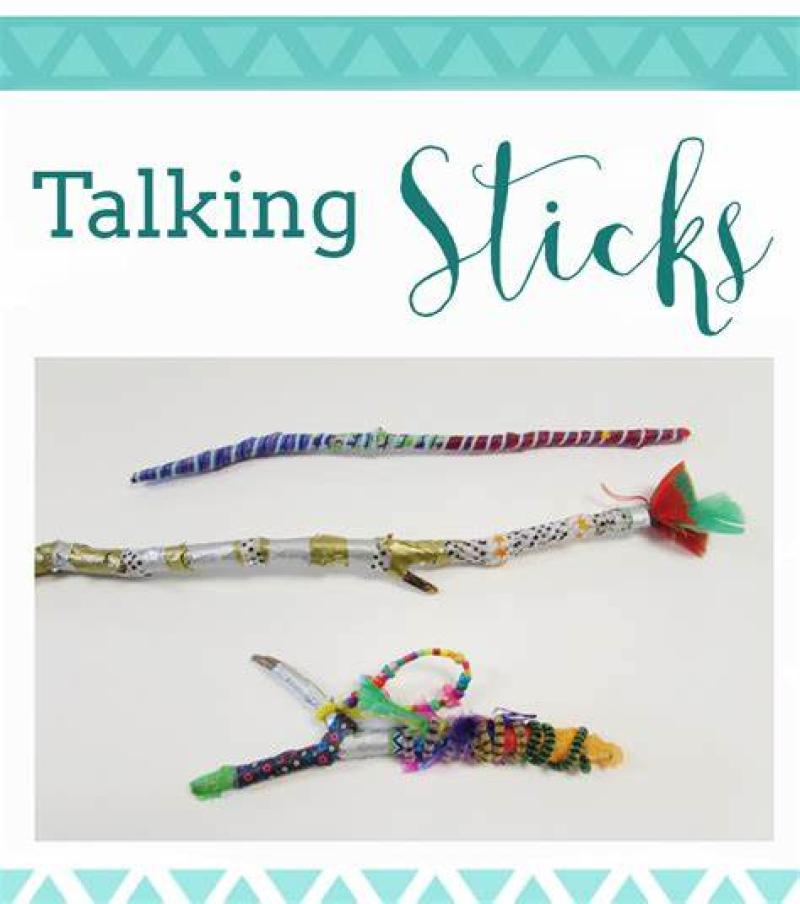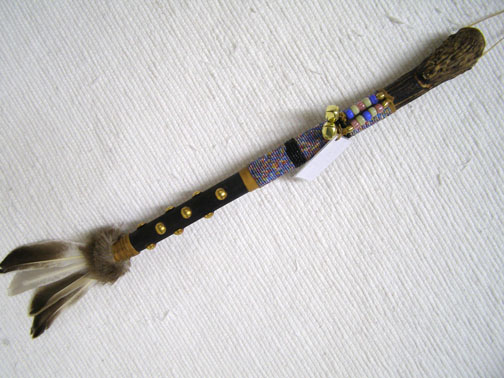Aboriginal Talking Sticks - Native Custom


Aboriginal Talking Sticks - Native Custom
Traditional Talking Stick

The Talking Stick is a tool used in many Native American Traditions when a council is called. It allows all council members to present their Sacred Point of View. The Talking Stick is passed from person to person as they speak and only the person holding the stick is allowed to talk during that time period. The Answering Feather is also held by the person speaking unless the speaker address a question to another council member. At that time, the Answering Feather is passed to the person asked to answer the query. Every member of the meeting must listen closely to the words being spoken, so when their turn comes, they do not repeat unneeded information or ask impertinent questions. Indian children are taught to listen from age three forward; they are also taught to respect another's viewpoint. This is not to say that they may not disagree, but rather they are bound by their personal honor to allow everyone their Sacred Point of View.
People responsible for holding any type council meeting are required to make their own Talking Stick. The Talking Stick may be used when they teach children, hold council, make decisions regarding disputes, hold Pow-Wow gatherings, have storytelling circles, or conduct a ceremony where more then one person will speak.
Since each piece of material used in the Talking Stick speaks of the personal Medicine of the stick owner, each Talking Stick will be different. The Qualities of each type of Standing Person (Tree) brings specific Medicine. White Pine is the Peace Tree, Birch symbolizes truth, Evergreens represent the continued growth of all things. Cedar symbolizes cleansing. Aspen is the symbol for seeing clearly since there are many eye shapes on the truth. Maple represents gentleness. Elm is used for wisdom; Mountain Ash for protection; Oak for strength; Cherry for expression, high emotion, or love. Fruit woods are for abundance and walnut or pecan for gathering of energy or beginning new projects. Each person making a Talking Stick must decide which type of Standing Person (Tree) will assist their needs and add needed medicine to the Councils held.
The ornamentation of each stick all have meaning. In the Lakotah Tradition, red is for life, yellow is for knowledge, blue is for prayer and wisdom, white is for spirit, purple is for healing, orange is for feeling kinship with all living things, black is for clarity and focus.

The type of feathers and hide used on a Talking Stick are very important as well. The Answering Feather is usually an Eagle Feather, which represents high ideals, truth as viewed from the expansive eye of the eagle, and the freedom that comes from speaking total truth to the best of one's ability. The Answering Feather can also be the feather of a Turkey, the Peace Eagle of the south, which brings peaceful attitudes as well as the give and take necessary in successful completion of disputes. In the Tribe that see Owl as good Medicine, the Owl feather may also be used to stop deception from entering the Sacred Space of the Council.

The skins, hair or hides used in making a Talking Stick brings the abilities, talents, gifts and medicine of those creatures-beings to council in a variety of ways. Buffalo brings abundance; Elk brings physical fitness and stamina; deer brings gentleness; rabbit brings the ability to listen with big ears; the hair from a horse's tail or mane brings perseverance and adds connection to the earth and to the spirits of the wind. If an illness of heart, mind, spirit, or body has affected the group gathering, snake skin may be wrapped around the Talking Stick so that healing and transmuting of those poisons can occur. The Talking Stick is the tool that teaches each of us to honor the Sacred Point of View of every living creature.
Tags
Who is online
41 visitors

A tradition that should be followed by everyone, not just Native Americans.
Congress should take up the use of the talking stick. Something just might get accomplished for a change.
I have one friend who I'd probably have to hit with the Talking Stick to get her to stop interrupting people.
In the Lakotah Tradition, red is for life, yellow is for knowledge, blue is for prayer and wisdom, white is for spirit, purple is for healingorange is for feeling kinship with all living things, black is for clarity and focus.
I would love to have one of each, but I could not have an eagle feather as it is illegal for me as a non Indian to own one. I do however have an eagle feather tattoo (for spirit), a bear paw (for strength), and decorative steer skull (for luck).
You can have one with the Eagle feather replaced by a turkey feather...Feathers of all birds have meaning to natives..
I actually do have some turkey feathers on a dream catcher I have.
The Ojibwe were the first to use the ''Dream Catcher''....In our language it's called a ''Asabikeshiinh'' or spider becaue of the webbing.
This is my dream catcher. It's mounted over the headboard of our bed. I know it's really for children but surely it should work for everyone. I don't know what kind of feathers are hanging from it.
I love all dream catchers. They are works of art and pure beauty.
Talking Sticks are a great enforcer of harmony, honesty and integrity during meetings because everyone understands the sacredness and strength embodied in the person holding the Stick while speaking, knowing that truth and honor are being expressed.
The Talking Stick is used in most of the meetings of the Boards of the Native American organizations I'm associated with and it's absolutely interesting how the meetings, for the most part, are conducted without rancor, hate, dishonesty. The flow of words and discussion is, usually, smooth, healing and very understandable. Decisions are made with strength and conviction and, most importantly of all, with consensus.
I can remember the couple meetings hosted between the military leaders and Tribal/Nation leaders where Talking Sticks were utilized. At the beginning of the meeting when the Stick was introduced, you could see the "unease" of the military folks. I mean, they were/are used to directing how the discussion would flow to enable them to reach the decisions they had already made and the use of the Stick changed their mind flow dramatically in a couple of cases. You could see the tensions and uncomfortable body shiftings at the beginning being replaced with relaxed posture, straighter body language, easier flow of discussion and more rapid consensus. One BGen I worked with, after the first initiation to the Talking Stick, started using the Stick in his other Staff meetings. At the beginning, the meetings were halting conversations filled with tensions. After a few meetings, the Staff understood and accepted the use of the Stick and many folks were amazed at the ease of the meetings and the positive outlook of the members as they left.
Here's a photo of me gifting Wilma Mankiller a Talking Stick after her first election. From what I understand, she used the Stick at her Council meetings.
I think Kavika is right. Congress and Senate and the Federal Administration should all be required to use talking sticks in their meetings.